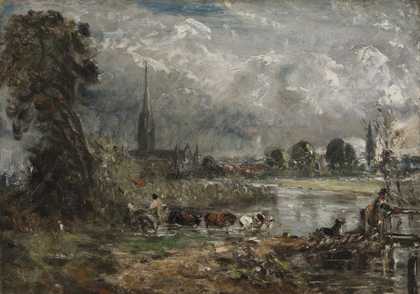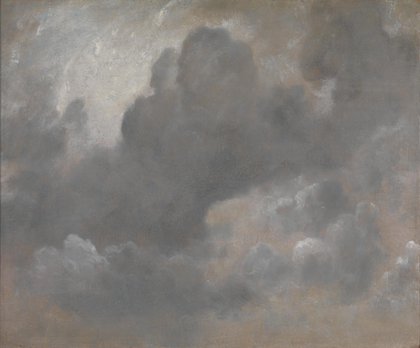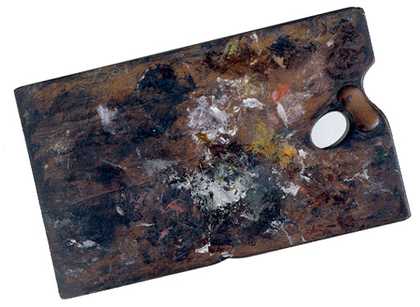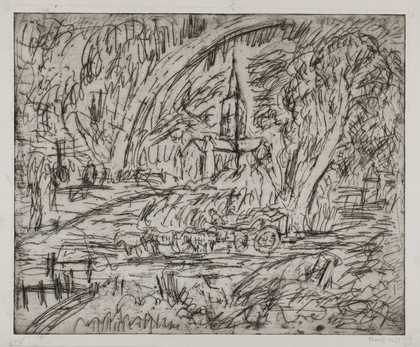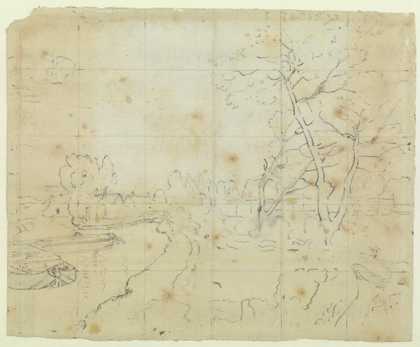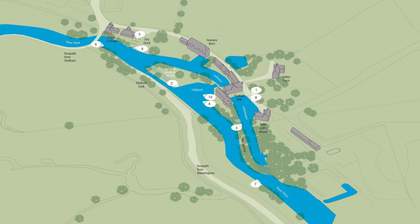
John Constable once recalled ‘I associate my “careless boyhood” to all that lies on the banks of the Stour’. He grew up at Flatford Mill on the River Stour in Suffolk, which his father owned. In many of his best known paintings and sketches he captured the places close to his boyhood home and the scenes of everyday rural life there.
The locations shown in these iconic paintings and studies, are all within a surprisingly small area close to the mill.
1. The Mill Stream 1810–1814
In this study the mill stream is seen from the forecourt of the Constable family mill at Flatford. They owned two corn-grinding watermills on the river Stour, at Flatford and at Dedham. The stream had been diverted from the River Stour to work the mill’s water-wheel.
2. Flatford Mill from a lock on the Stour ca. 1811
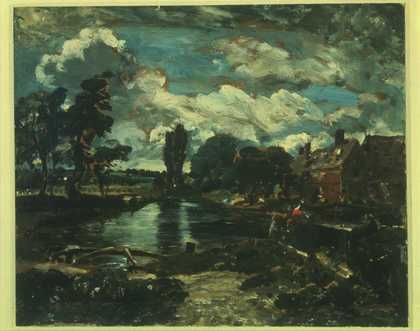
John Constable
Flatford Mill from a Lock on the Stour ca. 1811
© Victoria and Albert Museum, London
This study for a painting exhibited at the Royal Academy in 1812 combines aspects of Constable’s earlier studies for this view. The river, painted in deep perspective, is framed by buildings and trees to create a satisfying composition. Constable deleted the figure at the left – a man opening the lock gates – in the final composition.
3. The Valley Farm 1835
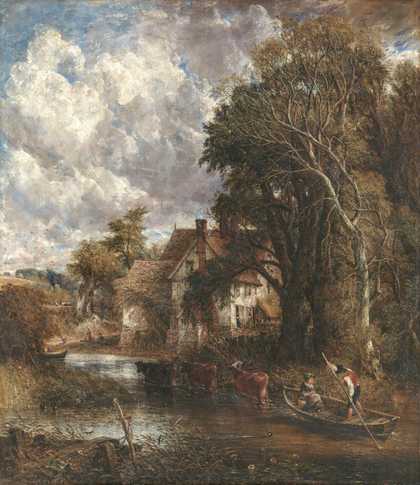
John Constable
The Valley Farm (1835)
Tate
This late painting shows a view of Willy Lott’s House at Flatford from the River Stour. The farmer lived continuously in the same house for over eighty years and for Constable it came to represent an important part of the Suffolk landscape, a nostalgic symbol of the ‘natural’ way of life.
The house is viewed through the cutting that led from the river Stour to the mill stream of Flatford mill. The composition is based on two earlier workings of the subject, The Ferry 1814, (private collection) and, more particularly, Willy Lot’s House from the Stour 1816–18 (private collection).
4. Flatford Lock from the Mill House c.1814
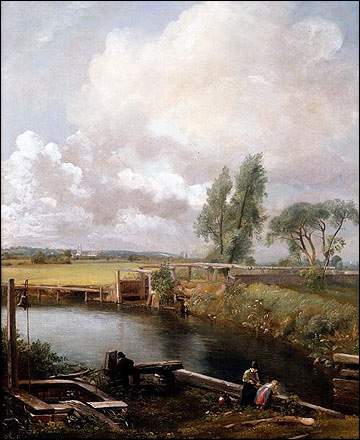
John Constable
Flatford Lock from the Mill House ca. 1814
This is a relatively newly discovered painting by John Constable. It shows how at this period Constable returned to a smaller dimension for exhibition works in order to improve his ‘finish’ and detailing. The feathery foliage of the black poplar trees on the far right suggests he had followed his contemporary Joseph Farington’s recent advice to study the French seventeenth century landscape painter Claude Lorrain.
What looks like a square well-head with a bell on a chain in the bottom left corner may be connected with a self-levelling system for locks.
5. Boat-Building 1814–15
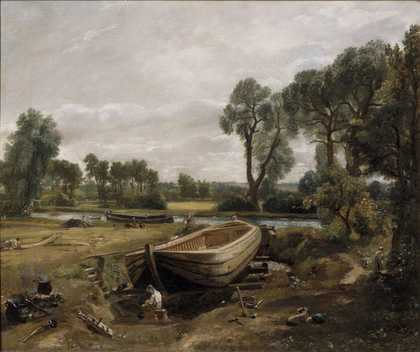
John Constable
Boat-Building near Flatford Mill 1814-15
Oil on canvas
© Victoria and Albert Museum, London
This oil painting documents the construction of a barge at a dry-dock owned by Constable’s father. It is based on a tiny pencil drawing in a sketchbook at the V&A. Constable painted the landscape entirely in the open air. His biographer C. R. Leslie praised its ‘atmospheric truth’, such that ‘the tremulous vibration of the heated air near the ground seems visible’.
6. Flatford Mill 1817
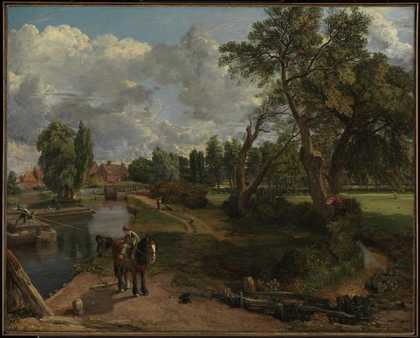
John Constable
Flatford Mill (‘Scene on a Navigable River’) (1816–7)
Tate
In this view of the mill, Constable shows a pair of barges travelling upstream. They are about to be disconnected from the towing-horse so that they can be poled under Flatford footbridge (just out of the composition to the left). Constable painted much of the picture on the spot in the summer of 1816.
7. The White Horse 1819
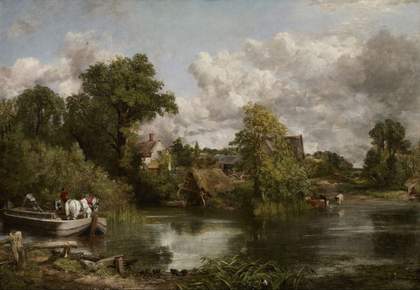
John Constable
The White Horse 1819
Copyright The Frick Collection
This is the first of a series of large-scale paintings Constable made in the early 1820s showing incidents in the working life of the River Stour. In The White Horse 1819, a horse is being ferried across the river. It was one of Constable’s favourite paintings. He commented in later years:
There are generally in the life of an artist perhaps one, two or three pictures, on which hang more than usual interest – this is mine.
The painting was well received when it was shown at the Royal Academy exhibition of 1819, and was purchased by Constable’s friend Archdeacon John Fisher. Constable bought back the painting in 1829 and kept it the rest of his life..
8. The Hay Wain 1821

John Constable
The Hay Wain 1821
Oil on canvas
Courtesy The National Gallery, London
The Hay Wain 1821, another of Constable’s large-scale ‘six-footers’ focuses on the hay cart under dense clusters of clouds. It evokes a specific midday moment as the cart turns towards the distant fields. Like his other works it was painted from sketches made on the spot.
9. View on the Stour near Dedham 1822
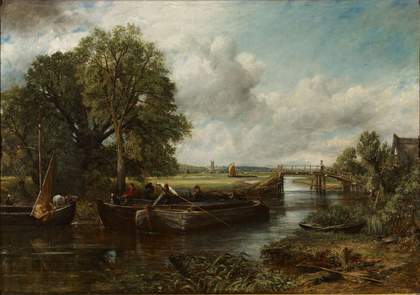
John Constable
View on the Stour Near Dedham 1822
© Courtesy of the Huntington Art Collections, San Marino, California
This view shows the River Stour winding its way past Flatford Bridge as it turns toward the town of Dedham. The town’s church tower rises in the distance. Constable blocked off the left side of the canvas with a group of trees to direct the viewer’s gaze to the distant meadow on the right. Strong diagonals in the composition – a tilting spar, a discarded rake, an abandoned boat – draw attention to the center of the canvas and the theme of labor.
10. The Lock 1824
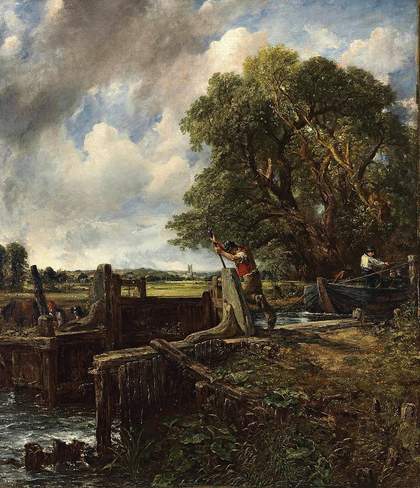
John Constable
The Lock 1824
The Lock shows a man struggling to open the canal gate at Dedham Lock. In the distance Dedham church can be seen across water meadows. The Lock is the fifth of Constable’s so-called six-footers, (the large-scale paintings he made of scenes on the River Stour).
When it was exhibited at the Royal Academy in 1824, The Morning Post commented: ‘Mr Constable contributes a landscape composition which for depth, sparkling light, freshness and vigorous effect exceeds any of his works.’ The painting was bought on the first day of the exhibition.

